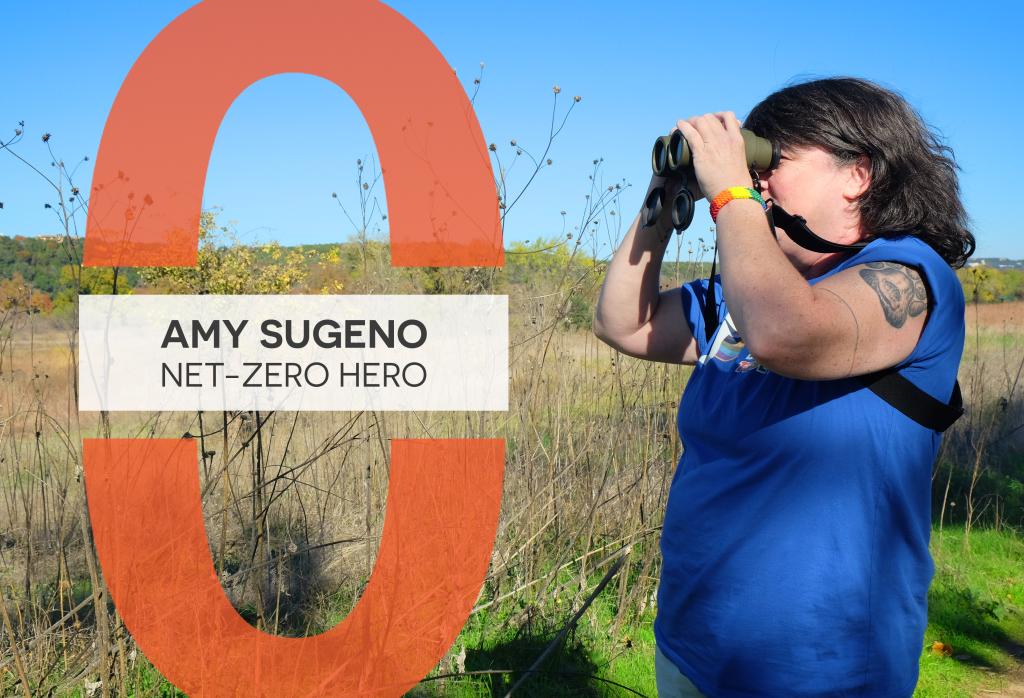Net-Zero Hero: Amy Sugeno
I’m helping to make Austin Net-Zero by helping people build meaningful and nourishing relationships with nature and each other.
It’s a new year — full of possibilities and resolutions for the months ahead. As we move into 2024, the Office of Sustainability looks forward to continuing to share the stories of individuals across our city who inspire us through their sustainable actions.
This month, in honor of National Bird Day (January 5) and Mental Health Awareness Month, we introduce you to Amy Sugeno, our newest Net-Zero Hero. Amy’s career has spanned sectors and roles, but at the heart of all she has done is the integral and ancient connection that exists between people and nature. From starting her professional journey as a wildlife biologist to leading birding walks for Austin’s queer communities, Amy embodies the Office of Sustainability’s vision of a thriving, equitable, and ecologically resilient community.
We met with Amy at Commons Ford Ranch, where we searched for birds, walked the trails, and learned more about her journey.
What inspired you to take action?
I care deeply about people and nature. We all live on this planet together, and we must do what we can to be in relationship with one another and with the earth. To be sustainable, our relationships must come from a place of compassion and care, and we must strive to be present and authentic with one another.
For as long as I can remember, nature has been my refuge and closest companion. Wandering through the fields and woods surrounding my childhood home is where I felt safe and able to be my truest self. I loved observing the daily lives of the animals and plants around me. Their relationships with each other — how they interacted with and depended on each other — fascinated me.
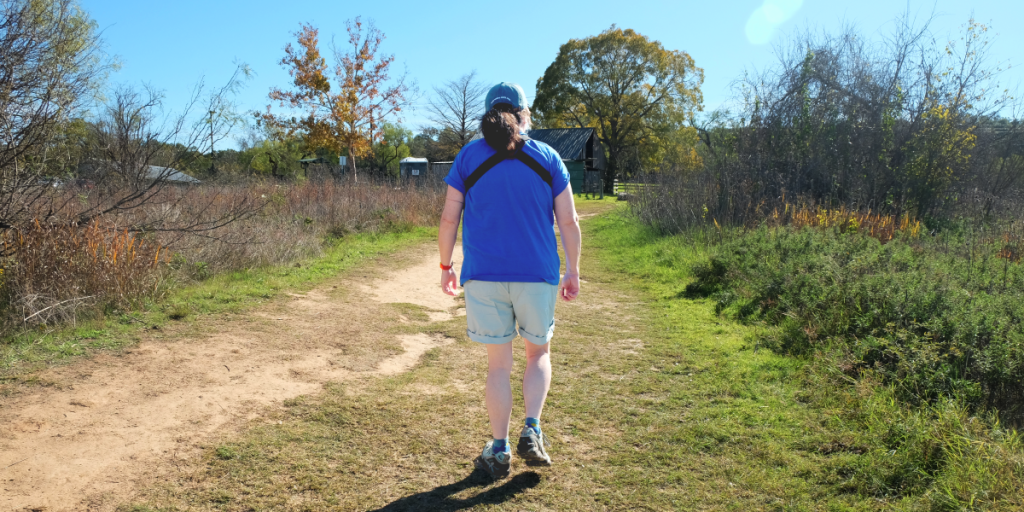
At home in nature, Amy walks a path at Commons Ford Ranch.
However, learning to feel safe in relationships with people took much longer. I cared very much about people but struggled to feel seen and heard. I wanted to be in relationships with others, so I focused on helping them feel valued and worthwhile. I wanted them to know someone cared about them. It took a while for me to find a healthier way to be in relationships, where I could offer my gifts of helping others and also help myself to know and feel my own value and worth.
My deep relationship with nature and my desire and struggles to feel safe, loved, and worthy in relationships with others have driven my lifelong passion to protect nature and help people have richer, more joyful lives.
How did you do it?
For most of my adult life, I have devoted myself professionally and personally to helping both nature and people. I was a wildlife biologist for over sixteen years, mostly working with bats, songbirds, and endangered species. Later, I worked as a social worker and mental health therapist with people experiencing domestic violence, sexual assault, and other types of trauma. I began offering a type of therapy called ecotherapy, which involves bringing nature into the healing process. Most recently, I returned to the classroom to work towards becoming an EMT. I hope to use this knowledge to help people who need emergency medical help, especially in wilderness areas. I love learning, and I love a good challenge! I don’t ever want to stop learning and growing.
Throughout my careers, I also created a variety of different programs to help people learn about nature and the outdoors. I started a birding camp for children, taught women how to camp and fly fish, led mindfulness in nature walks, and taught other mental health therapists how to offer ecotherapy in their work.
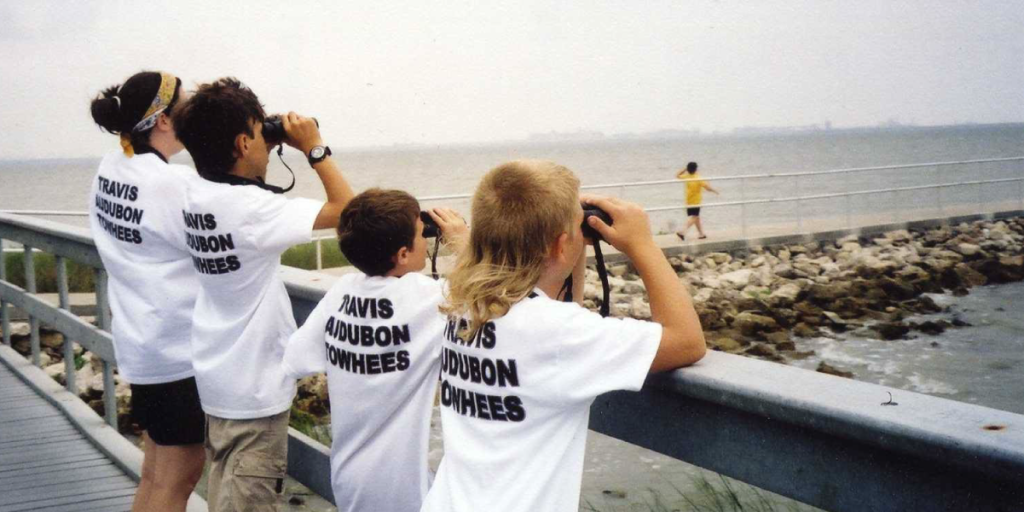
Participants in the birding camp led by Amy: the Travis Audubon Towhees.
About two years ago, I started leading monthly birding walks for the LGBTQIA+ community and allies. I came out as queer later in life and struggled to find a queer community of folks who also loved nature and the outdoors. I’ve been active in Travis Audubon for many years, and I approached them about organizing and leading birding walks intentionally inclusive of the queer community, and they were incredibly supportive and encouraging. The walks are also part of a larger program associated with the National Audubon Society called Let’s Go Birding Together (LGBT). Spending time outdoors in nature, especially in more rural and remote areas, is not always safe for queer people. The concerns span beyond physical safety. It can be extremely uncomfortable when you fear judgment for how you dress or talk or who you might bring with you, and many members of our queer communities live with the daily experience of not knowing if people will make incorrect assumptions about who they are and how they identify. The LGBT program aims to change this by offering safe, welcoming, affirming, and joyful opportunities to enjoy birds, nature, and the outdoors together without being afraid, invisible, and unwelcome.
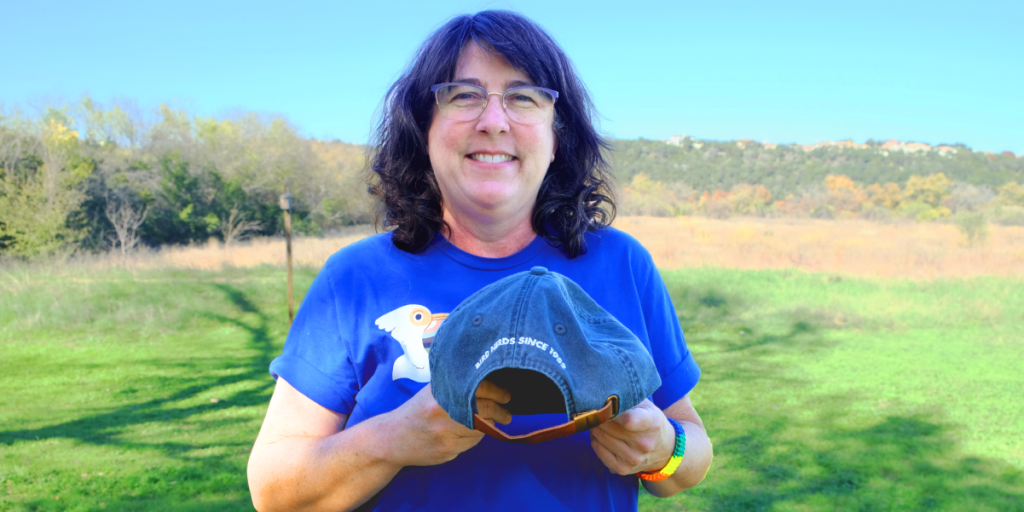
Amy holds up her Travis Audubon hat. The back reads, “bird nerds since 1952.”
As I get older, however, I am realizing that my ordinary, everyday actions are just as important as creating structured, formal programs. Being present, listening with intention and compassion, and finding moments to offer joy and kindness to someone’s day helps them feel cared about and can inspire them to offer the same to other people. Slowing down to savor the beauty and sacredness of a flower or bird or insect living their life deepens my desire to protect and conserve the habitats and ecosystems on which so many lives depend.
What’s been most rewarding about getting involved in this way?
As I get older, I have had experiences of being less visible than I was when I was younger. I also naturally have a little less energy than I used to, and I find myself visiting my doctor more than when I was younger.
I am very proud and happy about everything I accomplished in my first two careers. I know that my professional work as a wildlife biologist helped support nature through the environmental education programs, conservation efforts, and research I did. I also know that so many of the programs I created helped people in their relationships with each other and with nature. It is rewarding to know I have helped nature and people as much as I could up until this point in my life.
Now, it is rewarding to realize I can continue to help, even if the ways in which I try to help are different than when I was younger. It is satisfying to figure out new ways to continue my lifelong passion and love of helping nature and people. Structured, formal programs are wonderful and make a big difference, and it is rewarding knowing I can still help by simply slowing down, being present, and giving my time and care to others.
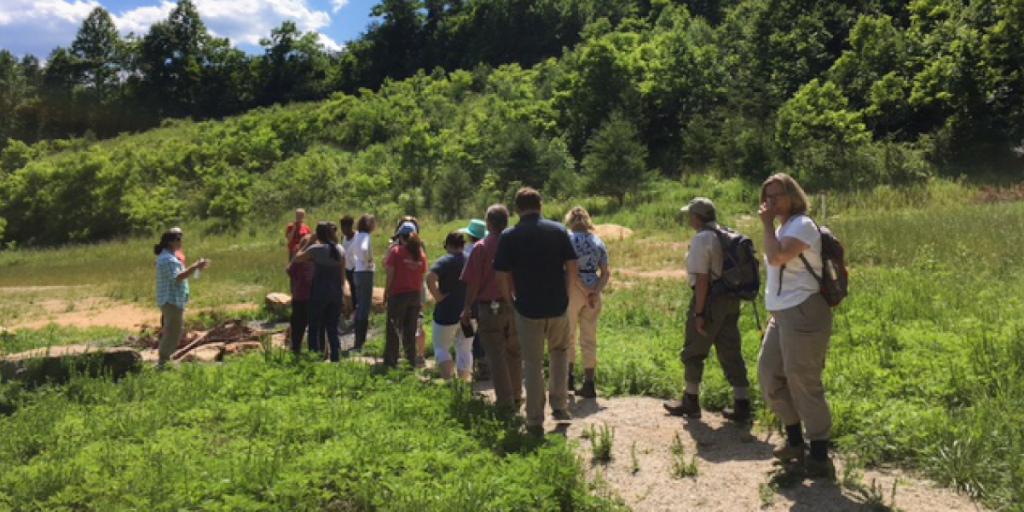
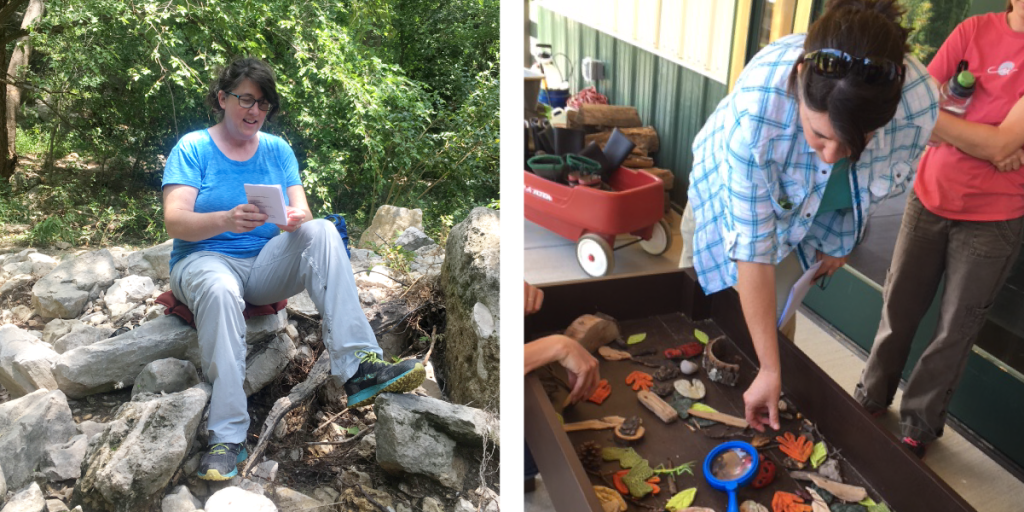
Top: Amy (far left) leads an ecotherapy presentation at a conference in Virginia. Bottom left: Amy leads a mindfulness in nature walk on the greenbelt. Bottom right: Amy prepares an observation table for a nature-based program.
What’s been the toughest part?
Throughout my life and work, I have seen habitat loss, pollution of beautiful streams and rivers, creek beds that have dried up because of increased development, violations of laws created to protect plants and animals, and mismanagement within private and governmental agencies tasked with protecting endangered species and other wildlife. At times, I have become anxious and depressed, overcome with worry that the lifelong work I have done, and am still doing, isn’t enough.
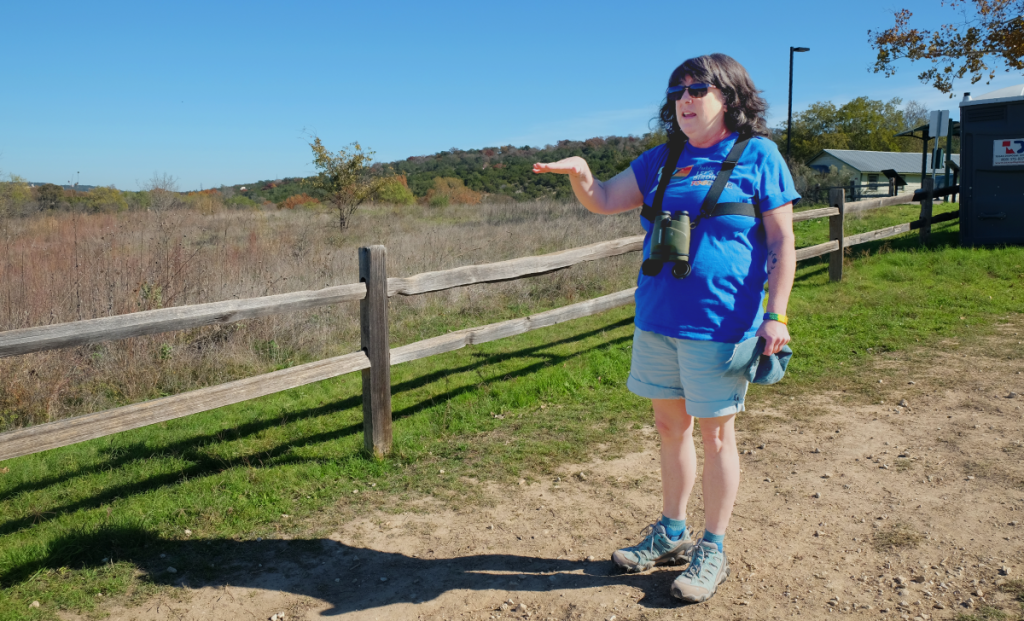
Amy pauses to point out the ecology of the prairie. She shares that they did a prescribed burn here last year and were amazed by the network of ants beneath the brush.
Your career path has taken some seemingly surprising twists and turns. What do you see as the throughline across all of your work? What’s next for you?
My parents used to tell a story about a time when I was three years old. I was apparently in love with the toads in our front yard. I gave them rides in my Hot Wheels. I went outside at night with a bucket and a flashlight so I could bring them inside. When my mother asked why I wanted to bring them inside, I told her I wanted them to have a home. I wanted them to feel safe and cared for.
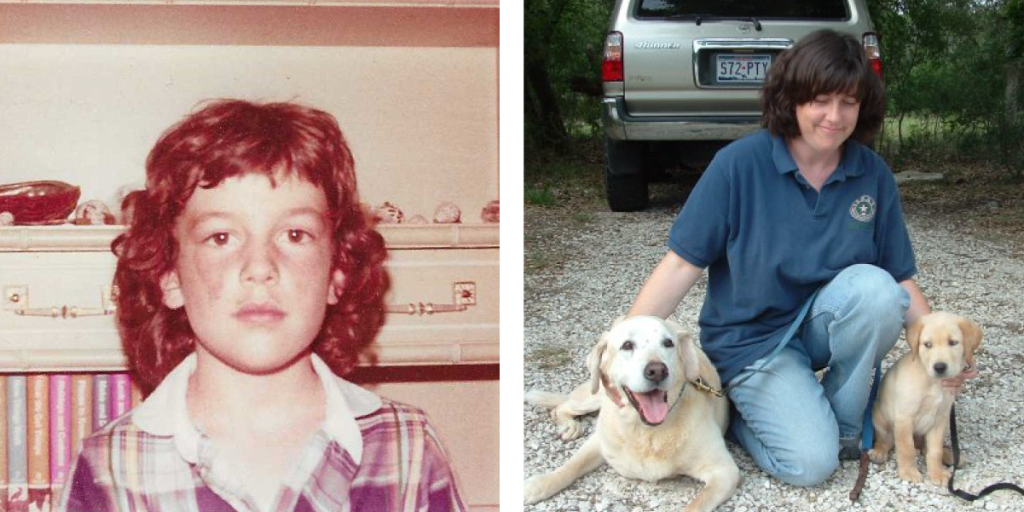
Left: Amy as a child. “I had just returned from a nature camp, and I was incredibly happy,” says Amy. “I remember thinking I wanted to look serious because that's how scientists should be.” Right: Amy in the field with some canine coworkers during her time with Texas Parks and Wildlife.
When I became a wildlife biologist, I thought that would be my only career. I wanted to follow in the footsteps of Jane Goodall, devoting my entire life to helping animals. At some point, however, the pull to want to help people who were suffering became so strong, I had to listen.
Now, in my fifties and living with chronic Lyme disease, I need to be back outside, doing what I can to help both people and animals. I recently passed my EMT exam, and I want to pursue becoming a Wilderness EMT. Over decades of camping and hiking, I have seen so many people who are not adequately prepared with the skills or knowledge needed to recreate outdoors safely. It has become important to me to help people learn how to keep themselves as safe as possible outdoors, which requires an understanding and respect for the animals, plants, and ecosystems whose homes they are entering and that they wish to enjoy.
January is Mental Health Awareness Month. As an ecotherapist, what are some simple activities that you would encourage readers to do to better connect with nature and themselves? Do you have some favorite local spaces for practicing ecotherapy?
In recent years, more and more books are being published, and more programs are being offered — each designed to teach people about connection to nature. We need to remember how to be in relationship with nature in a way that is not goal-oriented but instead is focused on nurturing a connection with the world around us. Forest bathing, for instance, which is actually an ancient practice, is becoming more familiar. There are people here in Austin who offer this and other similar nature connection programs.
My favorite practice is very simple: it is to pay attention, with intention, to the world around you. Sometimes, I carve out particular times, such as going on a hike or sitting on my porch, to do this. Other times, a bird, butterfly, or a pleasant breeze will catch my attention, and I pause to savor the moment. I allow nature to pull me into the present moment for a few seconds or a few minutes, however long I can. We are surrounded by these experiences all the time, but we must pay attention and notice. These experiences are truly gifts because they are constant. Even during the darkest, most difficult times in our lives, we always have the opportunity to pay attention.
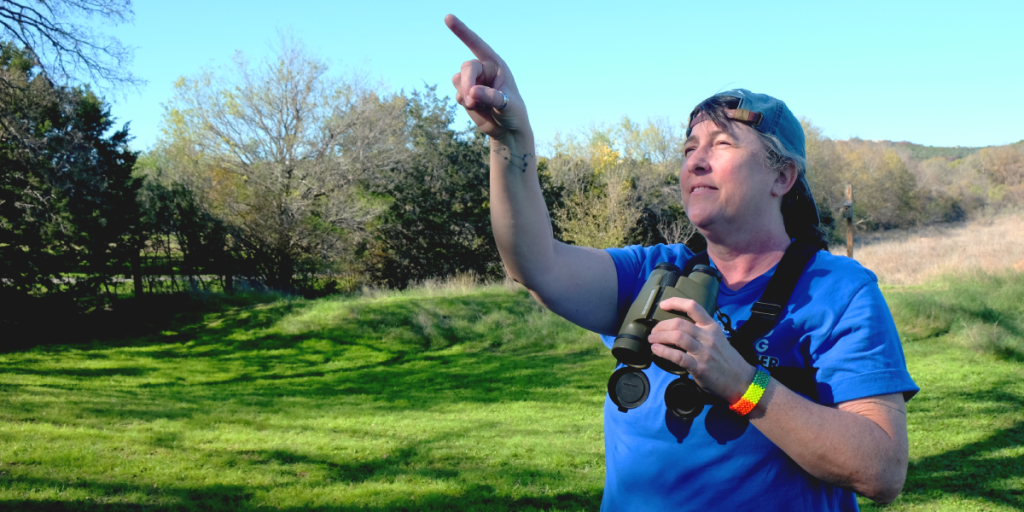
A treetop find: Amy points out a mourning dove in a nearby ash tree.
Is there a book, documentary, or other piece of media you would recommend for folks wanting to learn more about these topics?
A few of my favorite books are:
- Mindfulness & the Natural World: Bringing Our Awareness Back to Natureby Claire Thompson
- Zen Birding by David M. White and Susan M. Guyette
- Awake in the Wild: Mindfulness in Nature as a Path of Self-Discovery by Mark Coleman
What advice do you have for others?
Each of us has unique gifts and talents that can be used to offer joy, care, and compassion to the world. Some people have gifts that create visible and wide-ranging impacts. Others have gifts that are subtle and quiet. All gifts are important and necessary. Everyone’s gifts are needed.
The other piece of advice is simply to practice paying attention to the world around you. Notice the present — moment by moment — and be prepared to experience the fullness of life.
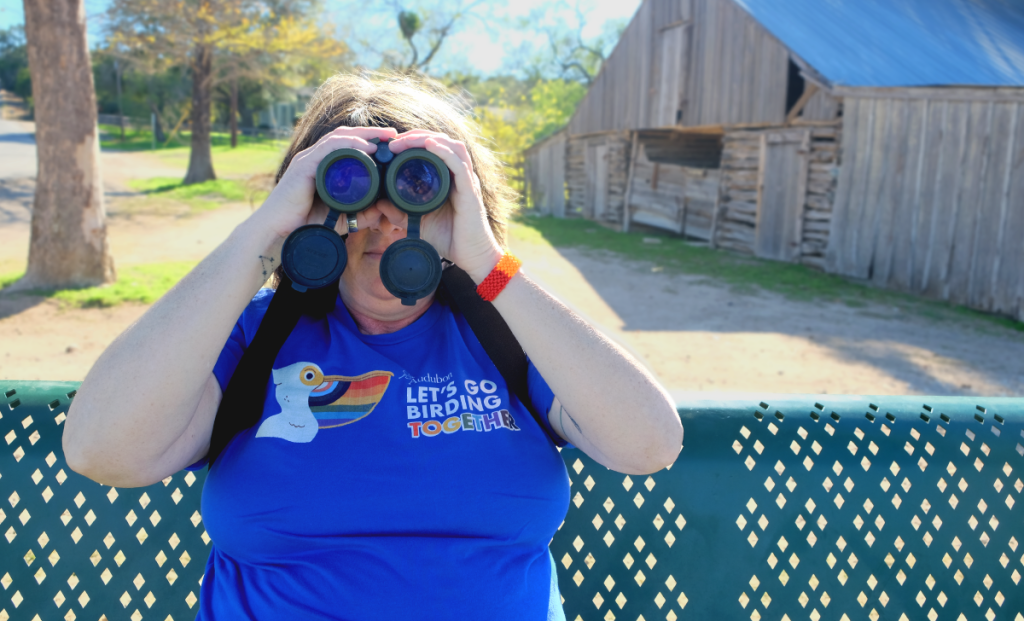
We’ve heard the expression “the canary in the coal mine.” Birds are an excellent indicator of the state of our planet, as the U.S. Geological Survey describes. Join Amy in her work by attending upcoming events with Travis Audubon.
To learn more about Austin’s net-zero goal and the actions you can take to support a greener community, view the Austin Climate Equity Plan.
Share your Net-Zero contributions with us on X (formerly Twitter) or Facebook, and use #NetZeroHero. If you know a Net-Zero Hero (or heroes!) who should be recognized for their efforts, send your nomination to climate@austintexas.gov.


